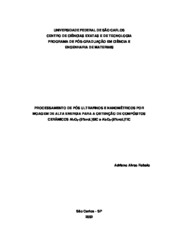Processamento de pós ultrafinos e nanométricos por moagem de alta energia para a obtenção de compósitos cerâmicos Al2O3-(5%vol.)TIC.
Abstract
The major objective of this thesis was to study the processing behaviour of Al2O3 ultra-fine and nanosized powders obtained by high energy milling
(HEM), to produce, after forming and sintering, Al2O3 .(5%vol.)SiC and Al2O3 .(5%vol.)TiC ceramics composites with high density. This aim arises from the fact that processing difficulties of ultra-fine powders are supposed to cause microstructural defects that are deleterious mechanical properties. Additionally,
the reactive HEM may be an alternative processing for obtaining nanometric powders. Such powders, however, presents processing problems that are not well characterized. Commercial Al2O3 and SiC powders and powders obtained by high-energy milling were used. Al2O3/TiC was obtained by reactive milling.
The majors on ceramic processing were: HEM and conventional ball milling stages deagglomeration, dispersion and mixture of the powders, forming by isostatic pressing and pressure slip casting. These experiments were carried out seeking to characterize the reliability in order to minimize the defects and
heterogeneities in the formed bodies. Different chemical methods were also verified for the SiC inclusions coating. In all those procedures, problems caused by the presence of strong agglomerates were observed, particularly in those
submitted to HEM. The inclusions coating methods through chemical precipitation did not succeeded probably due to the little affinity among the
inclusions surfaces and the precipitate. The best final results, verified by the high density, the inclusions dispersion homogeneity in microstructure and the flexure strength, were obtained with the improvement of ball milling processing for deaggregation and dispersion in alcoholic medium of the fine powders. For
powders from HEM was necessary an additional deagglomeration in a planetary illing. m.
